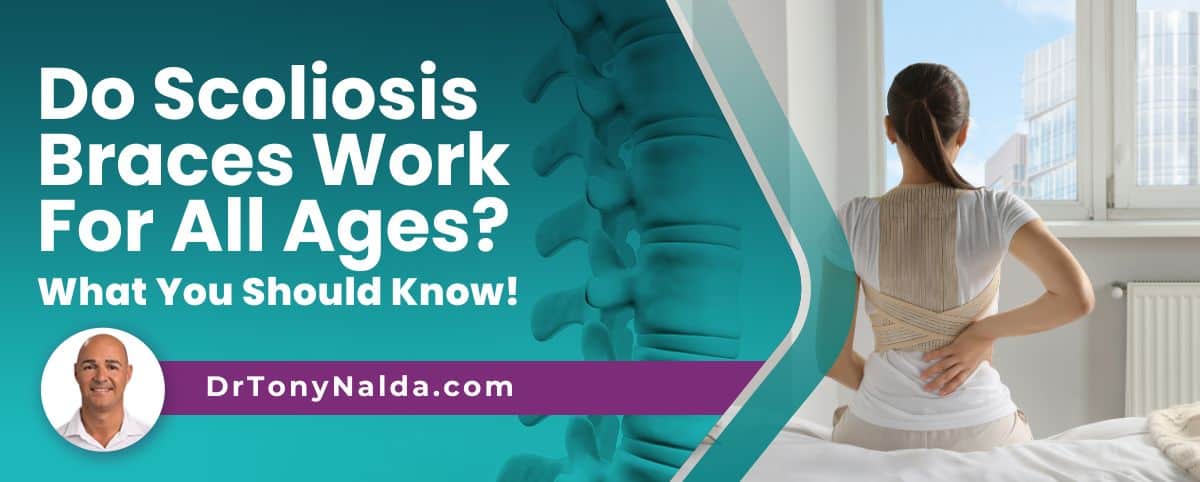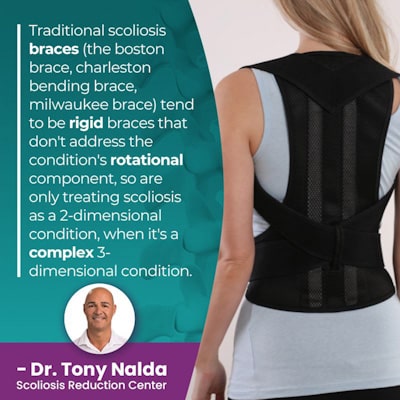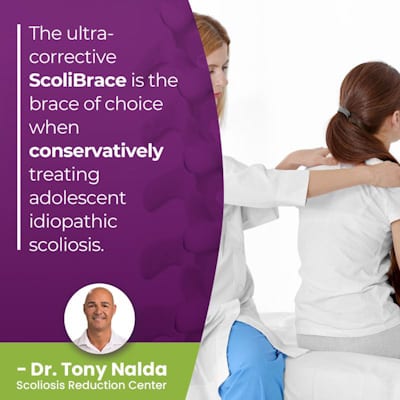Do Scoliosis Braces Work For All Ages? What You Should Know!

Just as there are different scoliosis treatment approaches with different goals, there are also different types of scoliosis braces that offer different potential results. When it comes to patient age and scoliosis bracing, spines that are still growing tend to be more malleable and responsive to treatment, so bracing is known as particularly effective on growing spines.
Scoliosis bracing can be a helpful facet of treatment, but it plays a different role when treating adults versus childhood scoliosis. It's most helpful to know the difference between corrective and traditional bracing.
As a different type of scoliosis brace is used by the two main scoliosis treatment approaches, let's discuss the main way these two approaches address scoliosis.
Table of Contents
Treatment Goal: Conservative versus Traditional
The two main scoliosis treatment approaches are modern conservative treatment and traditional treatment.
As scoliosis develops, an unnatural sideways and rotating spinal curve is occurring, and as it progresses, it's increasing in size, as are the condition's uneven forces, and their effects.
Scoliosis is incurable, but it can be highly treatable, and the main effect of scoliosis in children is postural deviation caused by the condition's uneven forces disrupting the body's overall symmetry.
The goal of scoliosis treatment differs between conservative and traditional treatment; the goal of modern conservative treatment is to work towards achieving corrective results, while the goal of traditional treatment is to stop it from progressing.
So corrective treatment wants to proactively prevent progression, increasing condition effects, and the need for invasive surgical treatment in the future by addressing the condition's underlying structural nature, and it works towards this through an integrative treatment approach that combines multiple scoliosis-specific forms of treatment, one of which is corrective bracing.
Traditional scoliosis treatment commonly involves watching and waiting, traditional bracing, and spinal fusion surgery.
Now that we've addressed how the two main scoliosis treatment approaches differ, let's talk specifically about the type of bracing favored by each.
Corrective Bracing versus Traditional Bracing
Corrective bracing has the goal of augmenting corrective treatment results and does so by pushing the spine into a corrective position.
 To be clear, no type of scoliosis brace would ever be enough to address scoliosis on its own, but when integrated into a proactive treatment plan capable of impacting conditions on every level, it can be an effective facet of treatment.
To be clear, no type of scoliosis brace would ever be enough to address scoliosis on its own, but when integrated into a proactive treatment plan capable of impacting conditions on every level, it can be an effective facet of treatment.
Here at the Scoliosis Reduction Center, I address scoliosis with a proactive conservative approach that combines chiropractic care, physical therapy and scoliosis-specific exercises, corrective bracing, and rehabilitation.
Corrective bracing represents the culmination of what we've learned about scoliosis and scoliosis bracing over the years, addressing many of the shortcomings associated with traditional bracing.
The ScoliBrace addresses the condition's true 3-dimensional nature, pushes instead of squeezes the spine, and is particularly useful when treating the condition's most-prevalent type: adolescent idiopathic scoliosis, diagnosed between the ages of 10 and 18.
Traditional scoliosis bracing has the goal of stopping progression, which is the goal of the entire treatment approach, but its efficacy is limited.
Traditional scoliosis braces (Boston brace, Charleston bending brace, Milwaukee brace, Rigo Cheneau brace) tend to be rigid braces that don't address the condition's rotational component, so are only treating scoliosis as a 2-dimensional condition, when it's a complex 3-dimensional condition.
Traditional bracing wants to stop the spine from becoming more unnaturally tilted, and does so by applying pressure along certain points of the curvature, squeezing the spine into a straighter alignment, known to weaken it over time.
So it's not just patient age that dictates how the spine responds to bracing, but also the type of brace used.
Patient Age and Brace Efficacy
Scoliosis braces can help address scoliosis in different age groups, and this is partially because scoliosis affects children and adults differently.
While patients of all ages can expect postural changes such as uneven shoulders, hips, and the development of a rib cage arch, the main effect of adult scoliosis is pain, and this is because scoliosis doesn't become a compressive condition until skeletal maturity has been reached.
So for adults for whom scoliosis tends to involve back pain and pain that radiates into the extremities, pain management is a focus of treatment, and this is a common use of bracing for adult scoliosis treatment, and in addition, bracing can also help increase spinal stability: important for adults experiencing natural age-related spinal degeneration.
When treating adult scoliosis, the goal of treatment is not to achieve a significant curvature reduction and hold it there throughout growth (growth is what triggers scoliosis progression), but is more about reducing the size of the scoliosis back to where it was prior to becoming painful.
So while bracing in adult scoliosis treatment is used more for short-term pain relief and improving the spine's stability, in children receiving conservative treatment, bracing is more about augmenting corrective treatment results.
As bracing can be particularly effective on growing spines, it's a common facet of adolescent idiopathic scoliosis treatment.
The ScoliBrace and Adolescent Idiopathic Scoliosis
The ultra-corrective ScoliBrace is the brace of choice when conservatively treating adolescent idiopathic scoliosis.
An issue with scoliosis bracing for this age group is compliance; regardless of a brace's design or purpose, if it's not work precisely as it was prescribed, its potential efficacy is limited.
 Sometimes, treatment involves full time bracing, which can mean wearing a brace for anywhere up to 23 hours a day for up to 5 years, and some braces are prescribed as nighttime braces.
Sometimes, treatment involves full time bracing, which can mean wearing a brace for anywhere up to 23 hours a day for up to 5 years, and some braces are prescribed as nighttime braces.
Considering a typical adolescent doesn't want to stand out from the crowd, wants to walk the same as their friends, look the same, and brace wear doesn't exactly help with that.
For traditional bracing that's known as bulky and uncomfortable, compliance is a big challenge, and the ScoliBrace addresses this issue by using state-of-the-art measuring and scanning technology so each brace is 100-percent bespoke to its wearer, so is more comfortable, less noticeable, and having a number of patterns to choose from helps adolescents further customize their ScoliBrace.
The ScoliBrace isn't known to be as tight fitting and cause as much skin irritation and/or breathing problems as a traditional sacral orthosis brace that can cause additional health problems and interfere with physical activity.
Treating Adolescent Idiopathic Scoliosis
When treating adolescent idiopathic scoliosis, the challenge is the condition's progressive nature being triggered by growth, and adolescents are going through puberty, characterized by rapid and unpredictable growth spurts.
So counteracting progression is a key focus when treating adolescents, but this is not such a treatment focus with other age groups not facing constant growth spurts.
The goal of treating adolescent idiopathic scoliosis is to work towards as significant a curvature reduction as possible, and holding it there, despite the constant trigger of growth, so monitoring how the spine is responding to growth and treatment is important so treatment disciplines can be adjusted accordingly.
When combined with chiropractic care, physical therapy, and rehabilitation, corrective bracing can be particularly effective when treating childhood scoliosis, and while no one treatment discipline can address scoliosis on its own, when the power of multiple scoliosis-specific forms of treatment is applied, there are fewer limits to what can be achieved.
Conclusion
So can a scoliosis brace work: when combined with other forms of conservative corrective treatment, brace treatment can be an important facet for addressing a child's unnatural spinal curvature.
When it comes to patient age, the big difference is progression, and as progression is triggered by growth, for young patients, the focus of treatment differs when treating adult scoliosis: counteracting progression during growth versus pain management and improving spinal stability.
Scoliosis braces work in different ways based on a number of factors that will vary from one patient to the next: patient age, condition type, severity, and curvature location.
Regardless of severity, as a progressive condition, the best time to start scoliosis treatment is always now; it only gets more complex to treat as it progresses, and increasing spinal rigidity that accompanies progression makes bracing less effective, which is why bracing is more commonly used when treating young patients whose spines are still growing.
Spines that are more flexible are more likely to respond to manual chiropractic adjustments, and corrective bracing can complement chiropractic care by pushing the spine into a straighter alignment.
Here at the Center, the keystone of my treatment approach is customization; each and every treatment plan is 100-percent customized to address the specifics of each patient's body/curvature type, and when it comes to scoliosis bracing, my experience is that corrective bracing offers better results, and this is partially because of the modern conservative treatment approach it's aligned with.
While scoliosis bracing is still used when treating adult scoliosis, wearing a scoliosis brace as an adult is more about short-term pain management and keeping the spine stable, particularly during treatment, than it is about augmenting corrective results in younger patients.
Dr. Tony Nalda
DOCTOR OF CHIROPRACTIC
After receiving an undergraduate degree in psychology and his Doctorate of Chiropractic from Life University, Dr. Nalda settled in Celebration, Florida and proceeded to build one of Central Florida’s most successful chiropractic clinics.
His experience with patients suffering from scoliosis, and the confusion and frustration they faced, led him to seek a specialty in scoliosis care. In 2006 he completed his Intensive Care Certification from CLEAR Institute, a leading scoliosis educational and certification center.
About Dr. Tony Nalda
 Ready to explore scoliosis treatment? Contact Us Now
Ready to explore scoliosis treatment? Contact Us Now





